SIGGRAPH2014 (Tog)
" Poisson-Based Continuous Surface Generation for Goal-Based Caustics "
by Yonghao Yue, Kei Iwasaki, Bing-Yu Chen, Yoshinori Dobashi, and Tomoyuki Nishita
Abstract
We present a technique for computing the shape of a transparent object that can generate user-defined caustic patterns. The surface of the object generated using our method is smooth. Thanks to this property, the resulting caustic pattern is smooth, natural, and highly detailed compared to the results obtained using previous methods. Our method consists of two processes. First, we use a differential geometry approach to compute a smooth mapping between the distributions of the incident light and the light reaching the screen. Second, we utilize this mapping to compute the surface of the object.
Keywords:
Caustics, surface generation, continuous, Poisson equation
Additional information
SIGGRAPHAsia2012
"Interactive Bi-scale Editing of Highly Glossy Materials"
by Kei Iwasaki,Yoshinori Dobashi, and Tomoyuki Nishita
Abstract
We present a new technique for bi-scale material editing using
Spherical Gaussians (SGs). To represent large-scale appearances,
an effective BRDF that is the average reflectance of small-scale
details is used. The effective BRDF is calculated from the integral
of the product of the Bidirectional Visible Normal Distribution
(BVNDF) and BRDFs of small-scale geometry. Our method
represents the BVNDF with a sum of SGs, which can be calculated
on-the-fly, enabling interactive editing of small-scale geometry.
By representing small-scale BRDFs with a sum of SGs, effective
BRDFs can be calculated analytically by convolving the
SGs for BVNDF and BRDF. We propose a new SG representation
based on convolution of two SGs, which allows real-time rendering
of effective BRDFs under all-frequency environment lighting and
real-time editing of small-scale BRDFs. In contrast to the previous
method, our method does not require extensive precomputation
time and large volume of precomputed data per single BRDF, which
makes it possible to implement our method on a GPU, resulting in
real-time rendering.
Keywords:
material editing, reflectance filtering, normal distribution
function, spherical Gaussian
Additional information
SIGGRAPHAsia2012
"An Inverse Problem Approach for Automatically Adjusting the Parameters for
Rendering Clouds Using Photographs"
by Yoshinori Dobashi, Wataru Iwasaki, Ayumi Ono,Tsuyoshi Yamamoto, Yonghao Yue and Tomoyuki Nishita
Abstract
Clouds play an important role in creating realistic images of outdoor
scenes. Many methods have therefore been proposed for displaying
realistic clouds. However, the realism of the resulting images
depends on many parameters used to render them and it is
often difficult to adjust those parameters manually. This paper proposes
a method for addressing this problem by solving an inverse
rendering problem: given a non-uniform synthetic cloud density
distribution, the parameters for rendering the synthetic clouds are
estimated using photographs of real clouds. The objective function
is defined as the difference between the color histograms of
the photograph and the synthetic image. Our method searches for
the optimal parameters using genetic algorithms. During the search
process, we take into account the multiple scattering of light inside
the clouds. The search process is accelerated by precomputing a set
of intermediate images. After ten to twenty minutes of precomputation,
our method estimates the optimal parameters within a minute.
Keywords:
clouds, rendering parameters, inverse problem
Additional information
SIGGRAPHAsia2010
"Unbiased, Adaptive Stochastic Sampling for Rendering Inhomogeneous Participating Media"
by Yonghao Yue, Kei Iwasaki, Bing-Yu Chen, Yoshinori Dobashi, and Tomoyuki Nishita
Abstract
Realistic rendering of participating media is one of the major subjects in computer graphics. Monte Carlo techniques are widely used for realistic rendering because they provide unbiased solutions, which converge to exact solutions. Methods based on Monte Carlo techniques generate a number of light paths, each of which consists of a set of randomly selected scattering events. Finding a new scattering event requires free path sampling to determine the distance from the previous scattering event, and is usually a timeconsuming process for inhomogeneous participating media. To address this problem, we propose an adaptive and unbiased sampling technique using kd-tree based space partitioning. A key contribution of our method is an automatic scheme that partitions the spatial domain into sub-spaces (partitions) based on a cost model that evaluates the expected sampling cost. The magnitude of performance gain obtained by our method becomes larger for more inhomogeneous media, and rises to two orders compared to traditional free path sampling techniques.
Keywords:
Participating media, free path sampling, space partitioning, Monte Carlo technique, unbiased
Additional information
SIGGRAPHAsia2008
"Extracting Depth and Matte Using a Color-Filtered Aperture"
by Y, Bando, Bing-Yu Chen, Tomoyuki Nishita
Abstract
This paper presents a method for automatically extracting a scene
depth map and the alpha matte of a foreground object by capturing
a scene through RGB color filters placed in the camera lens aperture.
By dividing the aperture into three regions through which only
light in one of the RGB color bands can pass, we can acquire three
shifted views of a scene in the RGB planes of an image in a single
exposure. In other words, a captured image has depth-dependent
color misalignment. We develop a color alignment measure to estimate
disparities between the RGB planes for depth reconstruction.
We also exploit color misalignment cues in our matting algorithm
in order to disambiguate between the foreground and background
regions even where their colors are similar. Based on the extracted
depth and matte, the color misalignment in the captured image can
be canceled, and various image editing operations can be applied
to the reconstructed image, including novel view synthesis, postexposure
refocusing, and composition over different backgrounds.
Keywords: computational photography, computational camera, color filters, color correlation, depth estimation, alpha matting
Additional information
SIGGRAPHA2008
"Feedback Control of Cumuliform Cloud Formation Based on Computational Fluid Dynamics"
by Y. Dobashi, K. Kusumoto, T.Nishita, T.Yamamoto, "
Abstract
Clouds play an important role for creating realistic images of outdoor
scenes. In order to generate realistic clouds, many methods
have been developed for modeling and animating clouds. One of
the most effective approaches for synthesizing realistic clouds is to
simulate cloud formation processes based on the atmospheric fluid
dynamics. Although this approach can create realistic clouds, the
resulting shapes and motion depend on many simulation parameters
and the initial status. Therefore, it is very difficult to adjust
those parameters so that the clouds form the desired shapes. This
paper addresses this problem and presents a method for controlling
the simulation of cloud formation. In this paper, we focus on controlling
cumuliform cloud formation. The user specifies the overall
shape of the clouds. Then, our method automatically adjusts parameters
during the simulation in order to generate clouds forming
the specified shape. Our method can generate realistic clouds while
their shapes closely match to the desired shape.
Additional information
SIGGRAPH2003
"Real-time Rendering of Aerodynamic Sound using Sound Textures based
on Computational Fluid Dynamics"
by Y.Dobashi, Tsuyoshi Yamamoto, Tomoyuki Nishita
Abstract
In computer graphics, most research focuses on creating images.
However, there has been much recent work on the automatic
generation of sound linked to objects in motion and the relative
positions of receivers and sound sources. This paper proposes a
new method for creating one type of sound called aerodynamic
sound. Examples of aerodynamic sound include sound generated
by swinging swords or by wind blowing. A major source of
aerodynamic sound is vortices generated in fluids such as air.
First, we propose a method for creating sound textures for
aerodynamic sound by making use of computational fluid
dynamics. Next, we propose a method using the sound textures
for real-time rendering of aerodynamic sound according to the
motion of objects or wind velocity.
Keywords:
Sound Synthesis, Animation, Aerodynamic Sound,
Simulation, Computational Fluid Dynamics.
Additional information
SIGGRAPH2000
"A Simple, Efficient Method for Realistic Animation of Clouds,"
by Y.Dobashi, K.Kaneda, H.Yamashita, T.Okita, T.Nishita,
Abstract
This paper proposes a simple and computationally inexpensive
method for animation of clouds. The cloud evolution is simulated
using cellular automaton that simplifies the dynamics of cloud
formation. The dynamics are expressed by several simple
transition rules and their complex motion can be simulated with a
small amount of computation. Realistic images are then created
using one of the standard graphics APIs, OpenGL. This makes it
possible to utilize graphics hardware, resulting in fast image
generation. The proposed method can realize the realistic motion
of clouds, shadows cast on the ground, and shafts of light through
clouds.
Additional information
SIGGRAPH'96
"Display of Clouds Taking into Account Multiple Anisotropic Scattering and Sky
Light"
by Tomoyuki Nishita, Yoshinori Dobashi, Eihachiro Nakamae
Abstract
Methods to display realistic clouds are proposed.
To display realistic images, a precise shading model is required:
two components should be considered.
One is multiple scattering due to particles in clouds, and
the other factor to be considered is sky light.
For the former, the calculation of cloud intensities has
been assumed to be complex due to
strong forward scattering.
However, this paper proposes an efficient calculation method using
these scattering
characteristics in a positive way.
The latter is a very significant factor when sky light is rather stronger
than direct sunlight,
such as at sunset/sunrise, even though sky light has been ignored in
previous methods.
This paper describes an efficient calculation method for light scattering due
to clouds
taking into account both multiple scattering and sky light, and the
modeling of clouds.
Key Words:
Clouds, Multiple scattering,
Sky light, Participating Media, Optical Length, Photo-realism, Radiative Tra
nsfer
Additional information
SIGGRAPH'94
"Method of Displaying Optical Effects within Water using Accumulation Buffer"
by Tomoyuki Nishita, Eihachiro Nakamae
Abstract
A precise shading model is required to display realistic images.
Recently research on global illumination has been widespread.
In global illumination, problems of diffuse reflection have been
solved fairly well, but
some optical problems after specular reflection and refraction still remain.
Some natural phenomena stand out in reflected/refracted light from the
wave surface of water.
Refracted light from water surface converges and diverges, and creates
shafts of light due to scattered light from particles.
The color of the water is influenced by scattering/absorption effects of
water molecules and suspensions.
For these effects, the intensity and direction of incident light to
particles
plays an important role, and it is difficult to calculate them in
conventional ray-tracing because light refracts when passing through waves.
Therefore, the pre-processing tracing from light sources is necessary.
The method proposed here can effectively calculate
optical effects, shafts of light, caustics, and color of the water
without such pre-processing by using a scanline Z-buffer and
accumulation
buffer.
Key Words:
Shaft of light, Caustic, Color of Water, accumulation buffer, Optical Length,
Photo-realism
Additional information
SIGGRAPH'93
"Display of The Earth Taking into Account Atmospheric Scattering"
by Tomoyuki Nishita, Takao Sirai, Katsumi Tadamura, Eihachiro Nakamae
Abstract
A method to display the earth as viewed from outer space (or a spaceship) is proposed.
The intention of the paper is application to space flight
simulators (e.g., reentry to the atmosphere) and the simulation of
surveys of the earth (comparisons with observations from weather
satellites and weather simulations);
it is not for geometric modeling of terrains and/or clouds
viewed from the ground, but for displaying the earth including the surface of the sea viewed from outer
space taking into account particles (air molecules and aerosols) in the atmosphere and water molecules in the sea.
The major points of the algorithm proposed here are the efficient
calculation of optical length and sky light, with lookup tables
taking advantage of the facts that the earth is spherical, and that sunlight is parallel.
Key Words:
Earth, Atmospheric Scattering, Optical Length, Sky light,
Color of Water, Photo-realism, Radiative Transfer
Additional information
SIGGRAPH'90
"Ray Tracing Trimmed Rational Surface Patches"
by T.Nishita, T.Sederberg, M.Kakimoto
Abstract
This paper pr/esents a new algorithm for computing the points at which a ray intersects a
rational Bezier surface patch, and also an algorithm for determining if an intersection
point lies within a region trimmed by piecewise Bezier curves. Both algorithms are based
on a recent innovation known as Bezier clipping, described herein. The intersection
algorithm is faster than previous methods for which published performance data allow
reliable comparison. It robustly finds all intersections without requiring special
preprocessing.
Key Words:
Computer graphics, ray tracing, visible surface algorithms, parametric surfaces.
Additional information
SIGGRAPH'90
"A Lighting Model Aiming at Drive Simulators"
by E.Nakamae, K.Kaneda, T.Okamoto, T.Nishita
Abstract
Many techniques for rendering natural objects such as the sea, terrains, and trees have
been developed; they are indispensable for flight simulators. In this paper, techniques
for rendering road surfaces under various conditions are discussed. Rendering road surfaces
is quite useful for the evaluation of driving safety, and it will play an important part in
the development of drive simulators. Light sources with high intensity often disturb
drivers especially under wet road surface conditions.
This paper proposes two models, a reflection model for road surfaces taking into account
weather conditions, and a model on streaks of light taking into account both refraction and
diffraction of light. Some examples demonstrate the possibility of applications for drive
simulators in the future.
Key Words:
Photo-realistic image rendering, Drive simulator, Rendering wet roads,
Rendering puddles, Reflection model, Streaks of light, Refraction, Diffraction,
Optical filter.
Additional information
SIGGRAPH'89
"Three Dimensional Terrain Modeling and Display for Environmental Assessment"
by K.Kaneda, Kato, E.Nakamae, T.Nishita, Tanaka, T. Noguchi
Abstract
A technique for compositing computer generated images of buildings and background images
created from aerial photographs is described. The aerial photo data are mapped onto a
terrain model based on cartographic data. The technique can be used to pre-evaluate visual
impact of large scale construction by means of not only still images but also animations.
The technique can be briefly described as follows: 1) an accurate, three-dimensional
terrain model is created based on cartographic data. 2) a hierarchy of aerial photo data
at various resolutions is mapped onto the terrain model as a texture. 3) the height of
trees is taken into account in regions near the viewpoint. 4) allowing intersections of
terrain models with constructions facilitates geometric adjustments and shadowing.
Key Words:
Contour Line, Terrain Model, Visual Environment, Environmental Assessment,
Texture Mapping
Additional information
SIGGRAPH'87
"A Shading model for Atmospheric Scattering Considering Luminous
Intensity Distribution of Light Sources"
by Tomoyuki Nishita, Eihachiro Nakamae
Abstract
Studio spotlights produce dazzing shafts of light,
while light scatered from fog illuminated by automobile
headlights renders driving difficult. This is because the particles in the
illuminated volume become visible by scattering light. A shading
model for scattering and absorption of light caused by particles in
the atmosphere is proposed in this paper. The method takes into
account luminous intensity distribution of light sources, shadows
due to obstacles, and density of particles. The
intensity at a viewpoint is calculated by integration of scattering
light scattered by particles between the viewpoint and
a given point on an object. The regions to be treated in this manner
are localized by considering illumination volumes and
shadow volumes caused by obstacles in the illumination volumes.
Additional information
SIGGRAPH'86
"A Montage Method: The Overlaying of The Computer Generated Images onto a Background Photograph"
by E.Nakamae, K.Harada, T.Ishizaki, T.Nishita
Abstract
A system of computer programs has been established to generate high quality montage
image of considerable usefulness in architectural simulation which combine
computer-generated images and photographed background pictures.
Traditionally, there are two methods of creating architectural montages: (1) an artist
paints new buildings onto a background scene usually generated photographically, and
(2) a three-dimensional scale model is created to simulate the whole landscape, and this
model is then photographed. The montage method described here combines aspects of both
traditional montage methods with significant improvement in accuracy and reduction of
time and cost of preparation. Specifically, a digitized photograph is used as a background
scene onto which is superimposed a 3D computer-generated image of a new building. The
outstanding points of the new method are:
(i) The shading and shadows of each computer generated image are calculated with higher
accuracy, (ii) the fog effect is taken into account, and (iii) a new anti-aliasing technique
improves the quality of the final montage image.
Additional information
SIGGRAPH'86
"Continuous Tone Representation of Three-dimensional Objects Illuminated by Sky Light"
by T.Nishita and E.Nakamae
Abstract
Natural lighting models to date have been limited to calculation of direct sunlight.
However, this paper proposes an improved model for natural lighting calculations that
adequately considers both direct sunlight and scattered light caused by clouds and other
forms of water vapor in the air. Such indirect natural light is termed skylight and can
be an important factor when attempting to render realistic looking images as they might
appear under overcast skies.
In the proposed natural lighting model, the sky is considered to be a hemisphere with
a large radius (called the sky dome) that acts as a source of diffuse light with nonuniform
intensity. In order to adequately take into account the nonuniform intensity of such
skylight, the sky dome is subdivided into bands. The light intensity within individual
bands can be assumed to be transversely uniform and longitudinally nonuniform and therefore
the total luminance emanating form each band can be calculated more accurately.
The proposed method significantly improves the realism of natural lighting effects. Its
advantages are particularly apparent when simulating lighting under an overcast sky or
when rendering surfaces that fall within a shadow cast by an obstruction lit by direct
sunlight.
Key Words:
shading, sky light, shadows, interreflection of light, daylight factor,
distributed light source
Additional information
SIGGRAPH'85
"Continuous Tone Representation of Three-dimensional Objects Taking Account of Shadows and Interreflection"
by T.Nishita and E.Nakamae
Abstract
The effect of shadows and interreflection created by room obstructions is an important
factor in the continuous tone representation of interiors. For indirect illumination, in
most cases a uniform ambient light has been considered, even though the interreflection
gives very complex effects with the shaded images.
The proposed method for indirect lighting with shadows results in the following advanced
points:
1) The indirect illuminance caused by the surfaces of objects such as ceilings, floors,
walls, desks, desks, bookcases etc. gives added realism to images.
2) The proposed method is suitable for every type of light source such as point sources,
linear sources, and area sources.
Key Words:
Shading, interreflection of light, diffuse reflections, area light source,
shadows, penumbrae
Additional information
|
|
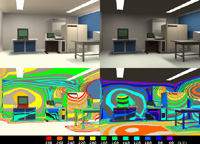

|
ACM85; Å@ACM Transactions on Graphics, Vol.4, No.2, pp,124-146, 1985-4
"Shading Models for Point and Linear Sources"
by Tomoyuki Nishita, Isao Okamura, and Eihachiro Nakamae
Abstract
The degree of realism of the shaded image of a tree-dimensional scene depends on the successful simulation of shading effects.
The shading model has two main ingredients, properties of the surface and properties of the illumination falling on it. Most previous work has concentrated on the former rather than the latter.
This paper presents an improved version for generating scenes illuminated by point and linear light sources. The procedure can include intensity distributions for point light sources and output both umbrae and penumbrae for linear light sources, assuming thr environment is composed of convex polyhedra.
This paper generalizes Crow's procedure for computing shadow volumes caused by the end points of the linear source results in an easy determination of the reions of penumbrae and umbrae on the face prior to shading calculation.
This paper also discusses a method for displaying illuminance distribution on a shaded image aby using colored isolux contours.
Key Words:
Lighting simulation, lumiinous intensity distribution
Additional information
Portal in ACM Lib.
T.Nishita in ACM Lib.
Tomoyuki Nishita in ACM Lib.

 ABSTRACT from My SIGGRAPH Papers (1/6)
ABSTRACT from My SIGGRAPH Papers (1/6)















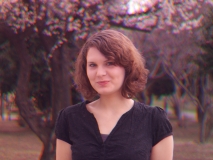

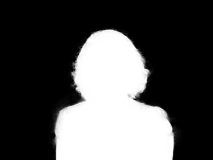











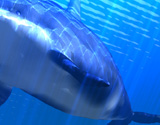

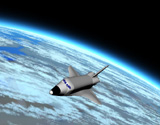
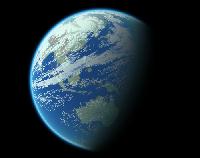

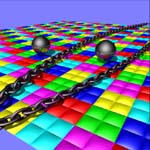
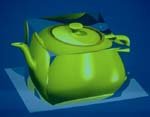
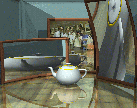
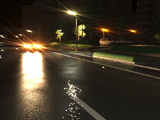
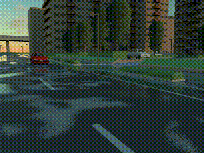
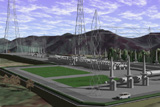
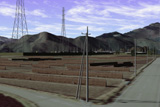
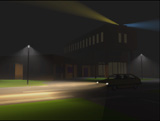
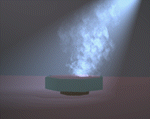
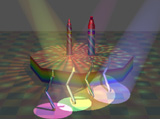
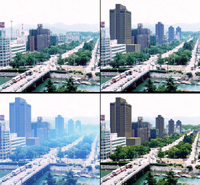


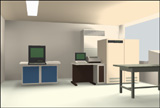


 pdf in ACM Lib. (1.99MB)
pdf in ACM Lib. (1.99MB)
 pdf.file
pdf.file



